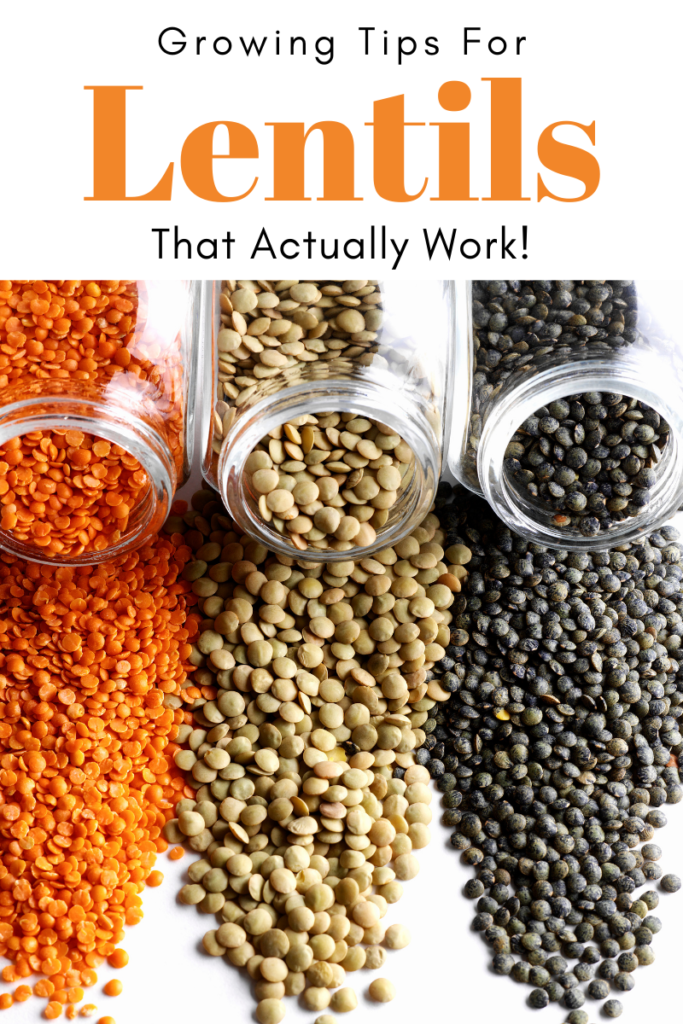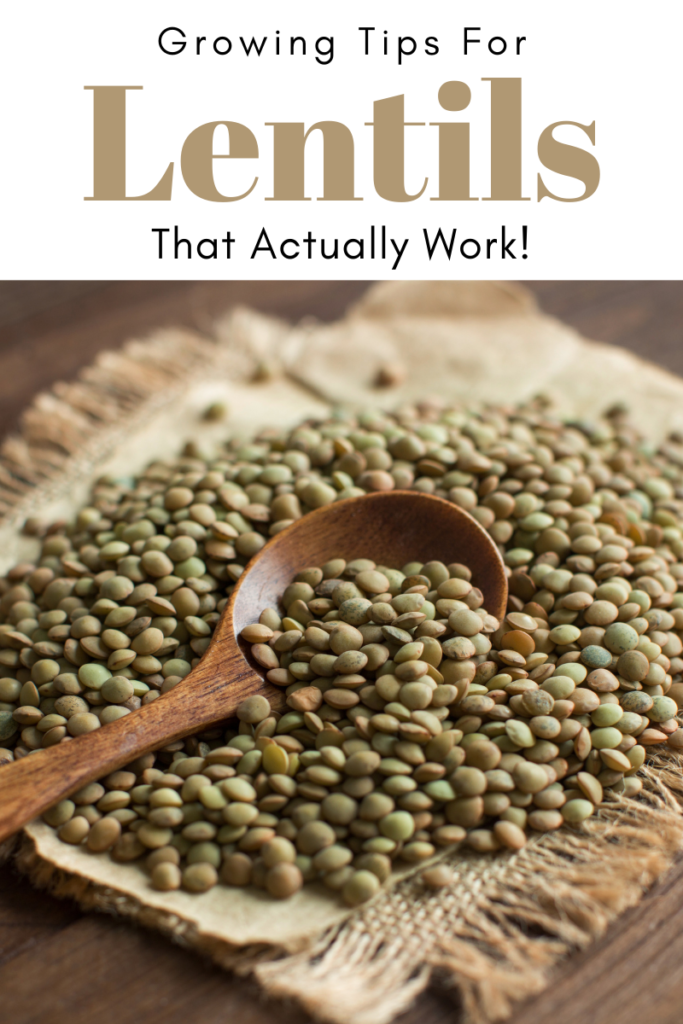This post contains affiliate links, which means I will make a commission at no extra cost to you should you click through and make a purchase. As an Amazon Associate I earn from qualifying purchases.
Have you ever thought about growing lentils? Lentils (Lens culinaris) are one of the oldest cultivated crops, and with proper care, they can be easily grown in almost any garden today. Their name appears in the Old Testament of the Bible, and researchers have found evidence that lentils were cultivated as far back as 6700 B.C. This nutritious member of the Pea family is still popular today and is a staple food in many cultures.

The lentil plant is bushy and can grow over a foot tall. They produce tiny flowers that are followed by flat pods that contain only a couple of seeds or less. There are several varieties available to gardeners, which are usually distinguished by color.
I love these for the versatility in recipes as well as how the different colors all have slightly different health aspects they generate. These were a godsend during the early days of COVID-19 when everyone was panic shopping and clearing the stores out of meat.
About Growing Lentils
Lentils are native to southern Europe and the Near East. The plants are quite hardy and are capable of withstanding heat and drought. They will flourish in the U.S. in Zones 5 and warmer. However, it is possible to grow lentils in cooler climates provided they have enough time to mature, which can take about 110 days.
The plants will need to be in full sun, and although they can endure poor soil conditions, they will thrive in nutrient-rich soil that is well-draining. The soil should have a pH of about 6.5. Because the pods hold very few seeds, approximately 40 plants will be needed to provide a good supply for a family.
Planting Lentils
The seeds can be planted directly into the garden after the chance of frost has passed. However, because they mature slowly, planting should be done as soon as possible after the last frost. Seeds should be planted about one inch deep and three inches apart. Germination takes just over a week, but seeds can be pre-germinated indoors in damp paper towels.
Lentil Basic Facts
Seed germinates in 8 to 10 days. The best temperature for germination is from 60 to 75 degrees Fahrenheit, but black-eyed peas will germinate from 40 to 80 F. As with bush beans, germination in ideal temperatures will take eight to 10 days, but it can take two weeks or more if soil temperatures are below 60 F.
Plant Black Eyes Peas in the spring, as they can only be grown in warm soil, with no risk of frost or cold, generally in the late spring and throughout the summer.
86 degrees Fahrenheit. This is a heat-loving vegetable that won't really take off until the air temperatures remain reliably warm.
You will want to grow 20-30 plants per person planning on eating them. You have to shell these buggers, like peas and it takes more plants than you would think.
First of all, it is traditional to kick off the new year with them - tons of recipes suggest it as a way to bring not only good luck, but prosperity.
These are best cooked, and are often served with greens, rice, and / or pork.
Planting Care
Once the plants are established, they should be thinned to about five to six inches apart and mulch around the plants to help deter weeds and hold in moisture. Good air circulation throughout the plants will help prevent mildew and other garden problems.
The lentils will only need to be watered in extreme conditions of no rainfall. The plants are highly tolerant to drought conditions. Once the pods begin to dry, they do not need to be watered even in extreme drought conditions. The plants can be fed right after thinning and then again as they begin to flower.
Harvesting Lentils
Lentils can be harvested during two different stages. They can be picked when they are still immature and used like snap beans. The pods can also be allowed to dry and then harvested. The dried seeds can then be used like dried beans. For best results, do not shell the dried seeds until ready to use.
Before storing, the pods should be frozen overnight to kill off any bugs that may be harboring in the pods. The pods can then be stored in an air-tight container in an unlit, dry place. Seeds can also be kept for future planting. They can be stored and should be used within three years.
Many ancient foods were used as treatments for different body ailments, including lentils. Today, lentils are more often an ingredient in different soups and stews. Lentils can also be ground to produce flour for making bread. They are frequently used in Indian cuisine, but their versatility makes them popular for a variety of recipes.
Benefits of Growing Lentils
Brown, green, yellow, red, or black — lentils are low in calories, rich in iron and folate, and an excellent source of protein. They pack health-promoting polyphenols and may reduce several heart disease risk factors. They’re easily cooked in 5–20 minutes
You can add lentils to your weight loss diet without feeling guilty. Lentils are long known for their protein and fiber content but are also low in calories and fats! A mere 1.5 cups of lentils contains just as much protein as a 3 oz chicken breast, but lentils contain the dietary fiber, copper, phosphorus, and manganese that you can’t get from meat. One cup of cooked lentils has nearly 18g of protein — more than the amount in a hamburger too! That is what makes growing lentils such an amazing idea.
See what Doctor Ann has to say about them:
Easy Lentils Recipe
Seriously, if I had to give up meat, I would probably be OK with it. We have done everything from making sloppy joes to soups. Just check out these 30 Ways for Cooking Red Lentils. The Red Lentil Bolognese Recipe for Pasta and Amazing Crock Pot Vegetarian Lentil Sloppy Joes recipes are total keepers! Keep in mind you can change the red out for green, or even black lentils.
Other articles you may enjoy if you like growing lentils:
- How To Grow Spinach Indoors: A Beginner's Guide
- How to Use Old Tires in a Garden
- How To Grow Tulips Indoors
- Avoid Plant Damage: How To Safely Use Mushroom Compost
- 7 Tips for Gardening With a Bad Back

